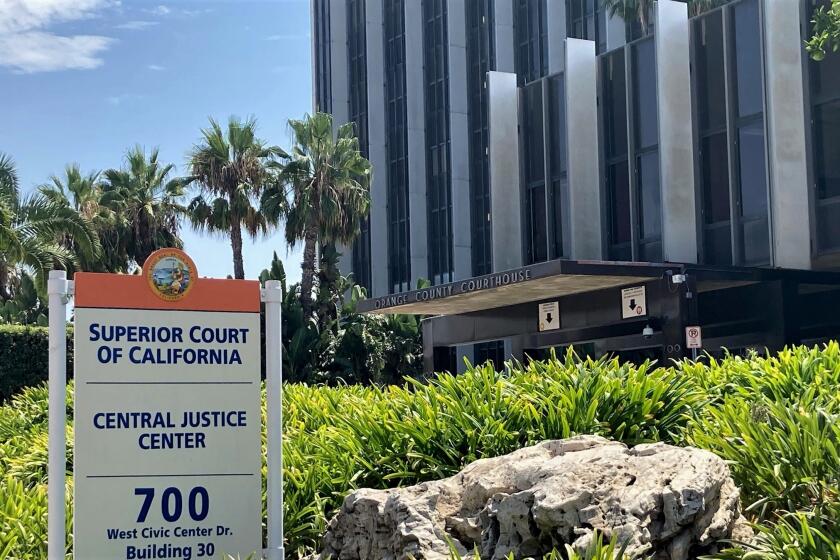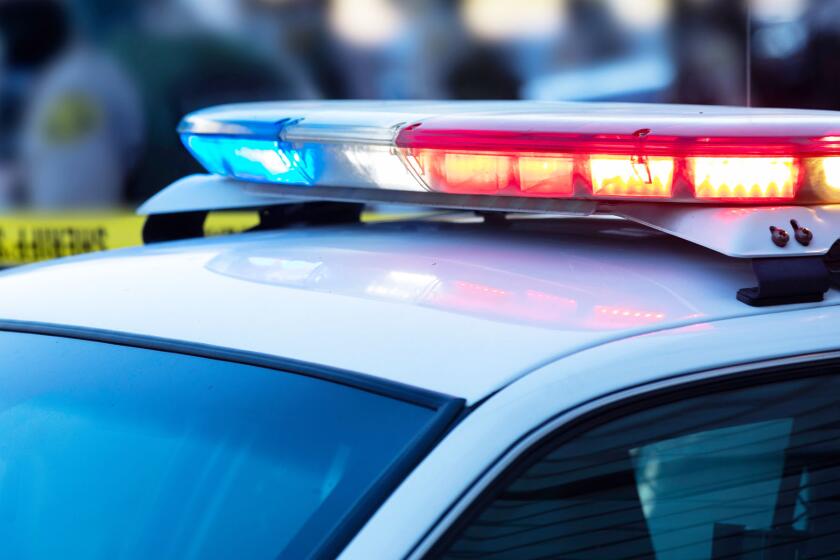Balboa Island residents defend Marine Avenue trees, fearing their loss during street upgrades
The towering mature eucalyptus trees that line Marine Avenue on Newport Beach’s Balboa Island could come down if the city makes extensive infrastructure upgrades in the area, and a group of residents wants to preserve the trees as part of the island’s history.
Residents say the trees are part of what makes the tight-knit island charming.
The city says tree removal isn’t imminent but also says that needed potential upgrades to aging pavement and concrete could mean the trees would lose their support system.
Island resident Jodi Bole is a tree champion. As a founder of the Balboa Island Preservation Assn., she rallies neighbors to protect Marine Avenue and specifically the trees. About half are Eucalyptus citriodora — lemon-scented gums about 40 to 60 feet tall and, one arborist estimates, up to 80 years old.
About 40 trees line both sides of Marine Avenue, Balboa Island’s Rockwellian main street of boutiques and cafes. Under their canopy, golf carts have designated parking outside the candy shop where saltwater taffy can be bought by the pound from cedar barrels. Several boutiques set out bowls of water for neighborhood dogs, and two snack stands claim to be Newport’s original purveyor of Balboa bars — chocolate-dipped, sprinkled blocks of vanilla ice cream on a stick.
“It doesn’t look like Irvine Avenue,” Bole said. “It doesn’t look like a mall.”
She points to a city policy on “special” trees, a designation for trees that “have historical significance and/or contribute to and give character to a location or to an entire neighborhood.” The policy says special trees must be retained unless there are overriding concerns about their health, hazards to people or interference with infrastructure.
Marine Avenue is among 40 locations in Newport with designated “neighborhood trees,” and its stand of eucalyptus trees is among the biggest groupings of special trees in town. Others include the soaring fan palms around Newport Center, Corona del Mar State Beach and Goldenrod Avenue, the date palms along Marguerite Avenue and the myrtles of West Newport Park.
“That means something,” Bole said. “These are landmark trees.”
Neighbor Jim Moloney agreed.
“If they are unique and special, they should be treated that way,” he said.
Last fall, residents pooled money to hire an independent arborist to evaluate the Marine Avenue trees. Greg Applegate, a tree consultant from Tustin, prepared a 53-page report concluding that the trees were in fair, stable condition, even if suffering from “30-plus years of less than ideal care” due to overpruning and artificial turf and constrained wells at the trunks’ bases.
The group also retained Rick Harlow, an arborist and head of the horticulture department at Orange Coast College in Costa Mesa, to assess the trees. He said they seem well-maintained. The largest specimens are about 70 to 80 years old and have grown into their surroundings, he said.
Applegate said lemon gums are not significantly messier than other trees and that toppling is rare without root defects or the purposeful stripping of bark around the trunk.
The city has a staff arborist and contracted tree trimmers who maintain the 38,000 trees on public property. They keep the Marine Avenue trees on an annual pruning cycle, as they overhang tight spaces with heavy foot and vehicle traffic, said Dave Webb, the city’s public works director.
Balboa Island — carved out of Newport Harbor around the turn of the 20th century — actually is an archipelago consisting of a main island, a “little” island and the tiny Collins Island. It is a former underwater sandbar turned vacation spot turned densely populated residential neighborhood. It got its first infrastructure in the 1920s, and much of that has come up for replacement recently.
Since 2017, Balboa Island has received a new bridge connecting the main and “little” portions, seawall caps, a new water main and dredging of the Grand Canal. Residents also have approved placing utilities underground on the island’s west side, and the city is planning to replace the 1930s-era drainage system.
Marine Avenue’s pavement is another major potential project.
Webb said a small group of island representatives met with the city about a year ago to begin sketching out ideas for refreshing the street. He said renderings showing palm trees were only a rough concept to start the discussion, and work will go through more vetting before getting to the City Council.
But he also said trees have life spans and that the Marine Avenue eucalyptus trees have shallow roots to avoid the harbor’s inhospitable salt water. The surface of the road and sidewalks supports the trees, and if that goes, so could the trees.
Councilman Jeff Herdman, a 64-year Balboa Island resident, said he likes the idea of improved streets and sidewalks but wants to study the tree issue more.
“You do not want a shopping center look, nor do I,” he told more than 100 residents gathered recently for a monthly neighborhood meeting overflowing with people holding signs supporting keeping the trees.
Bole said Pasadena and Laguna Beach have ideal preservation ordinances that Newport should emulate. She said she can’t do anything about the home redevelopment on the island, with original beach cottages being torn down for modern designs, but if the trees go, it’s all over for the island.
Bole said it’s ironic that the newly expanded and modernized Balboa Island Museum is under the shade of eucalyptus trees, which she said future generations should enjoy.
“I don’t feel like it’s ours to take away,” she said.
All the latest on Orange County from Orange County.
Get our free TimesOC newsletter.
You may occasionally receive promotional content from the Daily Pilot.




